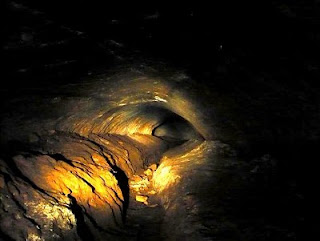
Paleo-Burrow. From [1].
Professor Dr. Heinrich Theodor Frank of the Instituto de Geociencias, Universidade Federal do Rio Grande do Sul [1], drew my attention to a very interesting subject,
Giant sloth burrows.
Dr. Frank studies the very interesting field of "
paleo-burrows", that is, the caves dug by ancient and now extinct creatures.
His specialty are the
Giant Sloth tunnels of which he has found many, though most belong to extinct giant armadillos, some are too large to have been dug out by them, and must have been excavated by giant sloths.
These tunnels are impressive, some are over 2 m (6.5 ft.) wide, 1.5 m (5 ft.) high and up to 30 m (100 ft.) long.
He and his team have discovered many paleo-tunnels (
paleotocas in Portuguese)in the southern state of Rio Grande do Sul, Brazil. Some paleo-burrows have been reported in Argentina, in the Pampa region.
However, none have been reported in Patagonia, which was home to the mylodon (see my post on the
mylodon saga).
One may believe that an animal as large as a mylodon could not be a burrower, in fact, there are no modern examples of burrowing mammals the size of a mylodon.
The largest living fossorial (burrow digging) creature is the aardvark, which weighs about 90 kg (200 lbs.). The mylodontidae on the other hand weighed up to 1200 kg ( 2,650 lbs.).
Argentine sloth burrowsThese have survived until our days and even display claw marks on their walls [3][4]. The size of these claw marks indicate that they were not made by any of the large armadillos that lived in the area during the last Ice Age. They were made by ground sloths.
Frenguelli even found a skeleton of a sloth (
Scelidotherium) within a burrow filled by volcanic ash.
Sloth remains (including dung) have been found in several caves in Chile and Argentina (not dug by them) which they must have used as shelters. These are located in the Andean area such as Cuchillo Curá or Cueva del Indio in Argentina or the famous Mylodon Cave in Chile.
But, for those giant sloths living on the flat plains of the Pampas, without trees or hills, their only shelter to avoid predation by carnivores would have been to "dig in" and burrow underground.
They may also have used them for protection against the extreme heat in summer, cold in winter and as a means to reduce their need for water; they may have even hibernated inside their burrows.
The sites of the known paleo-burrows in Argentina, are clay cliffs by the sea coast (Mar del Plata and Miramar)[5] or by a river (San Pedro).
Patagonian burrows?If there are any burrows in Patagonia, where would we expect to find them? Sloths lived in an environment very similar to what is now found in Patagonia: an arid steppe. There is evidence (from their dung) that they browsed on the same plants that can still be seen growing in Patagonia:
In addition to the dominance of grasses in the late glacial sample, the major difference between late glacial and modern vegetation is the absence of Larrea, a dominant shrub at the site today.[...] The pollen, plant cuticle, and chloroplast DNA analyses indicate that [...] sloths were feeding on plants similar to those that occur today at Cuchillo Cura´, and that they were living in Patagonian scrub-steppe. The slightly different proportions of the plant taxa, showing higher amounts of grasses,
suggest climatic conditions perhaps slightly cooler than the present.[2]
Their habitat was the grassy steppe. Perhaps their range did not extend across the arid stretches or the basaltic lava flows that cover some parts of Patagonia.
They would have surely lived in the Patagonian River Valleys, such as those of the Colorado, Negro, Neuquén, Limay, Chubut, Santa Cruz, Deseado rivers. These valley's abrupt walls (known as
bardas) would have provided an easy access to the under-soil for burrowing.
Though most of Patagonia is covered by a layer of gravel which may conceal many of these burrows, they must surely be there, waiting to be discovered.
Bibliography[1]
Paleo-burrows Project. Rio Grande do Sul University.
[2] Hofreiter M., Betancourt J.L., Sbriller A.P., Markgraf V., McDonald H.G. (2003).
Phylogeny, diet, and habitat of an extinct ground sloth from Cuchillo Curá, Neuquén Province, southwest Argentina. Quaternary Research, 59 (3), pp. 364-378.
[3] Frenguelli, J. (1928).
Observaciones geologicas en la region costanera sur de la Provincia de Buenos Aires. Universdad Nacional del Litoral, Facultad de Ciencias de la Educacion, Anales 3: 101-130.
[4] Vizcaino, S.F., Zarate, M., Bargo, M.S., and Dondas, A. (2001).
Pleistocene burrows in the Mar del Plarta area. Acta Palaeontologica Polonica 46: 289-301.
[5] Alejandro Dondasa, Federico I. Islab, and José L. Carballido, (2009).
Paleocaves exhumed from the Miramar Formation (Ensenadan Stage-age, Pleistocene), Mar del Plata, Argentina Quaternary International Volume 210, Issues 1-2, 1 December 2009, Pages 44-50.
Patagonian Monsters -
Cryptozoology, Myths & legends in Patagonia2010 International Year of Biodiversity Copyright 2009-2010 by Austin Whittall ©






















